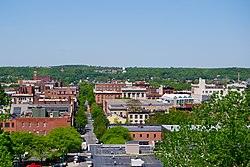Central Troy Historic District | |
 View west over downtown Troy from RPI, 2009 | |
 Interactive map showing Central Troy’s Historic District | |
| Location | Adams, 1st, 4th, Washington & Hill Sts., Franklin Pl., 5th Ave., Troy, NY |
|---|---|
| Coordinates | 42°43′39″N 73°41′27″W / 42.72750°N 73.69083°W |
| Area | 96 acres (39 ha) |
| Built | 1787-1940[1] |
| Architect | Various |
| Architectural style | Greek Revival, Victorian, Classical Revival |
| NRHP reference No. | 86001527 (original) 16000367[2] (increase) |
| Significant dates | |
| Added to NRHP | August 13, 1986 |
| Boundary increase | June 14, 2016[2] |
The Central Troy Historic District is an irregularly shaped, 96-acre (39 ha) area of downtown Troy, New York, United States. It has been described as "one of the most perfectly preserved 19th-century downtowns in the [country]"[3] with nearly 700 properties in a variety of architectural styles from the early 19th to mid-20th centuries. These include most of Russell Sage College, one of two privately owned urban parks in New York, and two National Historic Landmarks. Visitors ranging from the Duke de la Rochefoucauld to Philip Johnson have praised aspects of it. Martin Scorsese used parts of downtown Troy as a stand-in for 19th-century Manhattan in The Age of Innocence.[4]
In 1986, it was added to the National Register of Historic Places (NRHP), superseding five smaller historic districts that had been listed on the Register in the early 1970s.[5] (Two years later, in 1988, the extension of the previous River Street Historic District north of Federal Street was added separately to the NRHP as the Northern River Street Historic District.) In late 2014, the State Historic Preservation Board began considering an adjustment to the district's boundaries that would be a net expansion, particularly in its southeast;[6] that increase was made official in 2016.[2] Most of the buildings, structures and objects within the district contribute to its historic character. Two of Troy's four National Historic Landmarks, the Gurley Building and Troy Savings Bank, are located within its boundaries. Nine other buildings are listed on the Register in their own right. Among the architects represented are Alexander Jackson Davis, George B. Post, Calvert Vaux and Frederick Clarke Withers. There are many buildings designed by the regionally significant architect Marcus F. Cummings. The downtown street plan was borrowed from Philadelphia, and one neighborhood, Washington Square, was influenced by London's squares of its era.
The district reflects Troy's evolution from its origins as a Hudson River port into an early industrial center built around textile manufacture and steelmaking. During this period it was rebuilt twice in the wake of two devastating fires, resulting in its mix of architecture styles. After the decline of its industries in the mid-20th century, downtown Troy was threatened by urban renewal efforts that galvanized local preservationists, leading to the early NRHP listings and eventually the creation of the district.
Today, the city of Troy protects and preserves the district with special provisions in its zoning and programs which, with assistance from the state of New York, encourage and subsidize property owners who maintain and restore historic buildings. These efforts have paid off with increased attention from developers, the revival of much of the area, and praise from visitors to the city. With the collaboration of nearby Rensselaer Polytechnic Institute (RPI), Troy is hoping to make the district a center for the development of cutting-edge technologies, a "Silicon Valley of the 19th century."[7]
- ^ Peckham, p. 2
- ^ a b c "National Register of Historic Places announcements for June 24, 2016". U.S. National Park Service. June 24, 2016. Retrieved June 29, 2016.
- ^ Bernstein, Fred (April 7, 2006). "Where the Finest Antiques Can't Be Bought". The New York Times. Archived from the original on September 19, 2008. Retrieved November 7, 2008.
- ^ "Visit Troy". City of Troy. November 24, 2008. Archived from the original on December 22, 2008. Retrieved November 25, 2008.
Our architecture is in high demand by Hollywood for movies set in the nineteenth century, with movies such as "The Age of Innocence" and "Time Machine" having been filmed here.
- ^ Peckham, p. 3
- ^ LaFrank, Kathleen (October 2014). "National Register of Historic Places nomination, Central Troy Historic District (Boundary Expansion)" (PDF). New York State Office of Parks, Recreation and Historic Preservation. Retrieved November 22, 2014.
- ^ O'Brien, Tim (Spring 2004). "Reinventing Troy". Rensselaer. Rensselaer Polytechnic Institute. Archived from the original on October 26, 2008. Retrieved November 6, 2008.
© MMXXIII Rich X Search. We shall prevail. All rights reserved. Rich X Search


